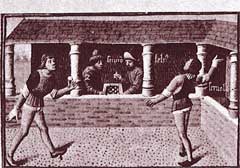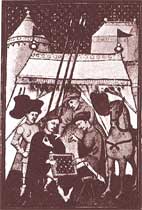Medieval Games
In exploring the games played in Medieval Europe, we'll just find out that the people of those times were no different from us, as they were fond of public amusements and they did their best to make their time pass agreeably.
In the early Norman times the favorite sports of the Medieval people were bowling, fencing with sword and buckler, the sword dance, and wrestling. At a later period came the Quintain.
The nobles had their own preferred games: tournaments including fencing, and hunting.
The emancipation of the serfs began to brighten the horizon of the peasantry. In the later years of the Plantagenet reigns, the village greens and the open spaces on the outskirts of the towns were the regular venues where the inhabitants were meeting to play their favorite games.

Tennis Game in the Middle Ages
Medieval burlesque games
The most popular occasions to watch or participate in the competitions were the village feasts. Besides wrestling matches, people enjoyed to watch the combats with sticks or birch boughs. Two men, blindfolded, each armed with a stick, and holding in his hand a rope fastened to a stake, entered the arena, and went round and round trying to strike at a fat goose or a pig which was also let loose with them. Nothing amused our ancestors more than these blind encounters, and even kings took part at these burlesque representations.
Games of skill and strength
This type of games became popular with members of all classes. Wrestling, running races, high and wide jumping, leap-frog, games of ball of all sorts, gymnastics, and all the other exercises strengthening the body and which were long in use among the youth of the nobility, became also the favorites of the bourgeois and villagers.
The Medieval game of the Quintain was a common sport at wedding festivities. It consisted of an upright post with a cross-post turning upon a pin. At one end of the latter was a broad board, at the other a heavy sandbag. The play was to ride against the broad end with a lance, and pass by quickly before the swinging sandbag could strike the player to the ground.
Ancestors of the modern games
Medieval FootballFootball has lived on in spite of royal proclamations and the protests of peace-loving citizens who objected to the noise, rough play, and other nuisances caused by the early version of the game. Edward II. and other monarchs regarded it as a "useless sport," which distracted the youth from practicing the noble sport of archery. Therefore it ought to be shunned by all loyal subjects.
There was indeed violence displayed at the matches, as mentioned by records from several writers condemning it severely. Fights, broken limbs, even deaths often resulted from Middle Ages football encounters. When the games were taken to the streets, broken windows marked the progress of the players.
Variations of Football, like la Soule or Soulette in France, or Calcio in Italy, were also popular. La Soule was played using a large ball of hay covered over with leather, the possession of which was contested by two opposing teams.
HockeyHurling was a fast and furious game, very similar to hockey, and played with sticks and a ball. Two neighboring parishes used to compete, and the purpose was to drive the ball from some central spot to one, or other, village. During the contest, the ball was driven over hills and ditches, through bushes and rivers, until the goal was gained.
CricketThe Medieval version of cricket seems to have been the club-ball, a very old game depicted in a picture in the Bodleian Library at Oxford, dated 1344 A.D. It represents a woman throwing a ball to a man, who is about of raising his bat to strike it. An even older picture shows two club-ball players: the batsman is holding the ball and preparing to hit it, while the other player holds his hands in readiness to catch the ball.
Stool-ball may be considered also to be an ancestor of cricket. It consisted in one player defending a stool with his hand from being hit by a ball bowled by another player. The stool was used as a wicket, and the hand for a bat.
Trap-ball is an older game, and can be traced to the beginning of the fourteenth century. Except the shape of the trap which holds the ball, it is very close to the modern cricket game.
GolfGolf was played with a crooked club or staff, sometimes called a bandy. It was probably introduced into Scotland from Holland, and then migrated to England. It was a popular pastime as early as 1457.
Tennis in the Middle AgesThe early tennis game was played with the palm of the hand. Later on the players used gloves, and afterwards bound cords round their hands to make the ball rebound more forcibly. This primitive device will become a tennis racquet in the 16th century.
France seems to be the original home of tennis, which became the favorite game of the nobles. In the 13th century it was still played in unenclosed spaces, but in the fourteenth it migrated to the towns, where walls enclosed the courts. There it also became the preferred pastime amongst the bourgeois. When the fashion was at its height, tennis courts were built everywhere. They were so spacious that were often converted into theatres.
BilliardsIn the 14th Century, people also enjoyed to play the game of billiards. It resembled the modern one only in name, as it was played on a level piece of ground with wooden balls which were struck with hooked sticks and mallets.

Playing Chess
The games of chance and strategy
The “sinful” games of the Middle Ages were always popular, although they were forbidden both by ecclesiastical and royal authority. New laws were continually being enacted against them, especially against those in which dice were used, though with little avail.
It appears more likely that dice were first forbidden by the Church, and then by civil authorities, on account of the fearful oaths uttered by those players who had a run of bad luck. It was very common for people to ruin themselves at this game, and, as a proof, the poems of troubadours are full of imprecations against the fatal chance of dice.
The games of cards like Triomphe, Piquet, Trente-et-un were much in fashion in France, and as much forbidden as dice. However, they were played in taverns and even at the court. Loaded dice and false cards were not uncommon, as many were cheating for a living.
On the opposite side were the games requiring skills and strategy. Generally known as Tables, they comprised all the games played on a board, particularly chess, draughts, and backgammon.
In France, it was Charles V who first thought of promoting only the Medieval games and sports having a more serious and useful character. In a celebrated edict forbidding the games of chance, he also encouraged the establishment of companies of archers and bowmen, to which was subsequently added that of arquebusiers.
